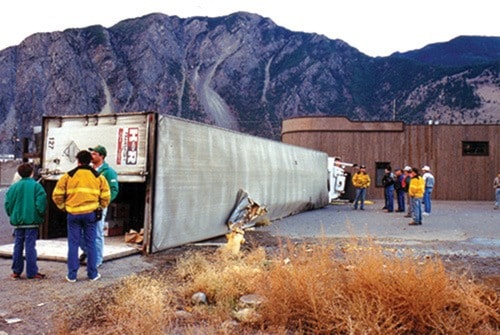Although this article follows on the heels of the recent Quebec disaster in Lac-Mègantic, this article wasn’t written to foment fear or advocate new trucking regulations.
There is a certain amount of danger in walking down the street in modern society - consciously or not, we accept a certain amount of risk everyday.
However, in the aftermath of a disaster such as what occurred in Lac-Mègantic, on July 5, a discussion around the question, “Could it happen here?” is worth having for the sake of awareness, if nothing else.
Highway 3 is a busy road, especially in summertime when tourists hit the road. It’s a busy highway for commerce as well, with an estimated 507 trucks per day safely passing through the Lower Similkameen and Keremeos.
Truck traffic through the village of Keremeos has been a perennially ongoing issue in the community, however, mainly due to safety concerns at the corner of Seventh and Seventh.
Noise is also an issue to many residents who live on or near Seventh Avenue.
After several years of lobbying, in late 2011, former Mayor Walter Despot managed to attract the attention of then highways minister Shirley Bond, who approved up to $750,000 for improvements to the intersection.
The main thrust of the project was to convert the north leg of the intersection to a single lane so that large tractor trailers could make right turns without encroaching on the opposite lane. The sidewalk width on the corner housing Royal LePage real estate offices was also reduced so that trucks turning right didn’t encroach on the sidewalk. As a result of a new stop sign on the westbound corner, traffic sometimes backs up beyond the firehall, especially during the higher traffic summer months, creating a new issue along the stretch of road.
It was the best option (approved by residents) with a final budget that came in at $339,000, that over time has failed to satisfy the safety concerns of many residents critical of the intersection. The disaster at Lac-Mègantic on July 5 brings to mind the question - should Keremeos residents be concerned about the prospect of a similar accident occurring here?
One concern stems from the loads contained within some of those shipments passing through the village - and the steep, eight per cent grade and sharp turn just east of Keremeos’ famous Seventh and Seventh intersection.
In 1988, for example, the base of the steep incline from the upper bench to the downtown core was the scene of a tractor trailer incident that, under the right circumstances, could have caused a major incident in the village.
A semi trailer, westbound on Highway 3, lost control on the grade and overturned near the site of what is now the Riverbed Bistro, blocking Sixth Avenue and narrowly missing Dutchies Transfer.
“There have been, I guess, at least five rollovers since 1973,” said Lorraine Vanderlinde. She theorized that the incidents dropped off when the last gas station closed on main street in the 1980s.
“People would fill their tanks, drive away, fuel leaking from an overfilled tank,” she said, “the hill would eventually get slippery, especially after rain.” Lorraine said the number of accidents on the corner has been way down since the service stations closed.
Watching traffic whizzing by the Review office on Seventh Avenue reveals an interesting mix of products being shipped through town. Most of the semi trailers passing by are carrying relatively innocuous cargo - lumber, logs, general merchandise, - but some carry freight that could definitely have a far reaching impact on the community, should an accident occur.
A casual assessment of traffic passing by the Review office over the past two months of placarded shipments (trucks carrying restricted goods, by law, must display placards with a four digit number and symbol that corresponds to a particular product as listed in Transport Canada’s Emergency Response Guidebook) revealed the following loads passing through Keremeos on a regular weekly basis:
2991 - carbonate pesticide, liquid, poisons, flammables
1789 - muriatic acid
1951 - Argon, refrigerated liquid
1079 - Sulfur dioxide
1203 - Petroleum
3077 - Biohazardous waste
3011 - Mercury based pesticide, liquid, toxic, flammable
When it comes to oil and other petroleum products, Keremeos no longer has to be concerned about multiple rail cars full of oil or petroleum products moving through the village, but there are a number of truck shipments - some of them tandem - of placarded 1203 (petroleum ) products passing through the community daily. Should one of those shipments have an accident at the bottom of the town hill, there could be issues, especially since the firehall is located right across the street.
In the event of a major calamity involving a rollover on this stretch of Highway 3 with a petroleum tanker, Keremeos emergency crews’ ability to respond would be affected prior to firefighters trying to get to the hall, which would be almost right on top of ground zero.
Under the Emergency Response Guidebook procedures, (which the Keremeos fire department would refer to when assessing an accident involving hazardous goods) an immediate evacuation of the area surrounding the accident site is recommended. For a burning petroleum tanker, the requirement is 800 metres in all directions - essentially the whole community would expect to have to evacuate - a huge order for a fire department that may be severely compromised from the outset.
Next week: Response measures that would likely be followed in the event of a major disaster at the bottom of town hill.
